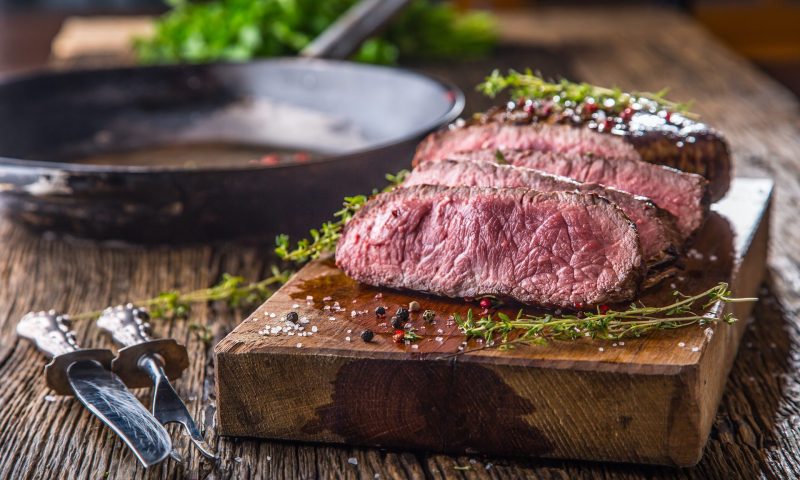The perfect doneness level on a steak can be a heavily debated topic. Some insist “the bloodier the better” and make quite the show about always ordering their steaks “blue.” Firstly, no, that red juice is not actually blood, and second, no one is impressed by this caveperson song and dance, so cut it out. On the other side of the scale, you have people who stubbornly insist upon ordering their steaks “well done.” We’ve found that this person is usually clinging to an antiquated fear that beef that isn’t cooked through is dangerous. While we understand that some lessons are hard to unlearn and sympathize deeply with those in the “well-done” camp, there’s nothing worse than a well-done steak.
If you ask us, medium-rare is the best way to order and cook a steak. It’s the perfect temperature that keeps the steak warm in the center while maintaining its tender, juicy, savory, natural beefy flavor.
A steak’s doneness affects not only how red it appears, but the flavor, texture, and juiciness inside, so it’s important to understand the temperature you prefer and how to achieve it when you’re cooking at home.
Steak temperatures

If you don’t already know exactly how you like your steak cooked, it’s important to know and understand the terminology for certain levels of doneness. So the next time your steakhouse server asks you how you would like your steak prepared, your options are as follows:
- Blue (extremely rare) (110 F–115 F). The steak is only just seared on the outside, and still totally raw and cold on the inside.
- Rare (120 F-125 F) The steak is completely red inside with a warm, but not cooked center.
- Medium rare (130 F-135 F) In our opinion, this is the best way to order a steak. The center is warm, red, juicy, and slightly cooked.
- Medium (140 F-145 F) The steak will have a pinkish center and a slightly firmer texture.
- Medium-well (150 F-155 F) A bit of pink will remain in the center of the meat when cut, but be mostly brown throughout.
- Well/well-done (160 F+) In our opinion, anything cooked further than medium is a crime, but ordering a well-done steak is an absolute travesty. The meat will be brown throughout with a firm, dry, flavorless texture.
How to cook steak to the perfect temperature

No matter how which temperature you prefer your steak to be, if you’re cooking your own at home, some tricks will help you get it right every time.
Bring your steak to room temperature before cooking. This process is called tempering your steak. While it may be tempting if you’re in a hurry to unwrap a steak straight from the refrigerator and toss it into the pan or onto the grill, it’s important to avoid doing this if you want even doneness in your steak. If your meat is cold when you put it on the heat, you’ll end up with cold spots and the steak won’t cook evenly. Keep in mind that the thicker your steak is, the longer it will take to temper.
Consider your cooking method. There are many ways to cook a steak, most of them delicious. Whether you’re grilling, pan-frying, reverse-searing, broiling, or even using a sous-vide machine to cook your steak, you’ll have different considerations to keep in mind when it comes to different levels of doneness. Each of these methods will prepare your steak in a different amount of time, so pay careful attention to your recipe’s instructions.
Generally, smaller steaks will cook considerably faster than larger, thicker steaks. If you’re looking for a medium or medium rare cook on small steaks, usually a quick sear and then a steady cook on lower heat for just an additional couple of minutes will provide great results. If your steak is on the larger side, however, you may want to consider a reverse sear to achieve the level of doneness you want.
Use a meat thermometer. No matter which cooking method you choose or what temperature you’re after, the only way to get the exact doneness you’re craving is to use a meat thermometer. There are many “hacks” out there that claim you can detect a steak’s doneness by comparing it to different parts of your palm, for example. These little tricks can be helpful about half the time. It’s best to rely on a good meat thermometer to avoid any under, or worse, over-cooked steaks.
Give it a rest. The best way to lose all of that precious, juicy flavor in a steak is to cut into it too quickly after cooking it. It’s true that this step can be torture, but the juices inside the meat need time to redistribute after the cooking process. If a steak is cut too soon, these juices will run all over your cutting board instead of staying in your steak where they belong.
Unless, of course, you prefer your meat well-done, in which case it doesn’t matter at all as your steak will be sucked dry of all that glorious juicy flavor anyway. But, you do you.




